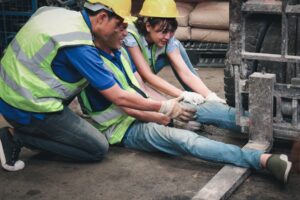Statistically, the construction industry experiences the most workplace deaths yearly, not just because it employs millions of workers. Employees face several hazards when they show up to work every day. They place their lives and well-being in the hands of every party at the site or in the vicinity. All it takes is a momentary mistake for a construction worker to suffer a severe injury that can change their life. To make matters worse, some employers may not invest enough in workplace safety. They may place their workers at risk every day, both from the employer's actions and those of others. According to OSHA, roughly one in every ten workers annually suffers an injury. Although many of these injuries will lead to workers' compensation claims, some can result in a successful third-party liability lawsuit. To do that you must prove that a third party bears legal responsibility for your injuries. Then, you may recover substantial financial compensation. First, contact an experienced construction accident attorney to review your legal situation and explain your legal options for potential financial compensation.
Falls
Falls are the most common cause of workplace injuries. According to the Centers for Disease Control, more than one-quarter of the nonfatal construction site injuries that cause workers to miss work result from falls. The construction industry accounts for nearly half of fatal fall injuries in the workplace. There are many potential causes of falls at a construction site. Since there are so many things going on at the site, it follows that there are many hazards. The contractor does not always take the time to ensure fall safety continuously. They may not provide adequate protection from falls or remedy dangerous conditions as they arise. Here are some common reasons for construction site fall accidents:- Poor scaffolding construction (either the assembly of the scaffolding or the materials used to construct it)
- Debris or construction materials that workers leave in a passage area
- Wet substances on the ground or a scaffolding
- Inadequate fall protection provided to workers (such as harnesses)
- Wires that are not correctly marked or covered
- Unsafe ladders on the work site (you can sue the company that made the ladder if the equipment itself was the cause of your injury)
Falling Debris
Construction projects can take place several stories above the ground. Whether from a skyscraper or a simpler multi-story structure, falling debris can cause serious injuries. Of course, the taller the structure, the more momentum debris can gather as it falls to the ground. Even a tiny falling object can cause serious injury if it drops from hundreds of feet in the air. The Bureau of Labor Statistics estimates that over 42,000 people suffer an injury each year from falling objects at a work site. This breaks down to one injury roughly every ten minutes. Falling objects can cause severe head and neck injuries. The head is often the first part of the body that falling debris will strike. Contractors may not take adequate steps to secure building materials on their sites. Even when they do, a small piece can break off anytime. Falling debris does not only mean equipment or materials that fall from a higher level. They may be flying materials or equipment on the construction site. For example, a piece of material may fly uncontrollably when a worker uses a power tool to cut it. Falling debris is the most common thing that will injure passersby near a construction site.Caught-Between Accidents
A construction worker can suffer devastating injuries or die in a caught-between accident by:- Getting caught in a soil collapse during excavation
- Trapped between a piece of equipment and a wall
- Caught under a piece of equipment that is on top of them
- Having a body part caught under a piece of equipment
- Wall collapses when the soil is undermined, or the wall itself did not have proper construction
Electrocution
A construction worker can sustain electrocution injuries on a work site from:- Inappropriately marked underground utilities
- Exposed or inappropriately covered wires
- Ladders and other equipment perilously close to active electric lines
- Overloaded electrical sockets
- Defective work equipment
Toxic Substance Exposure
Many chemicals are in use at or near a construction site. Workers might have frequent exposure to toxic substances that can make them ill. Although asbestos is no longer a common building material, there are other hazardous substances that workers may be near daily. Exposure to toxic substances can cause:- Infections
- Parkinson's disease
- Lead poisoning
- Chronic obstructive pulmonary disease
- Mesothelioma
- Silicosis
- Metal fume fever
Collapses
There are several ways that workers, or people in the vicinity, can be injured in a collapse at the site. First, the structure (or a part of it) can collapse during construction, injuring workers in the area. Second, the ground can collapse into a sinkhole, which can cause serious injuries. Several parties may cause collapses. Two commonly responsible parties in building collapse are the architect and engineer. In some cases, the building design itself was dangerous. You can file a lawsuit against a professional for negligence when they fail to meet their professional standards.Defective Work Equipment
Construction workers use many different pieces of work equipment on the job. Much of this equipment relies on electrical power and has sharp edges. Even a simple non-electric tool can cause serious injury considering the force a worker uses. Work equipment that has injured construction workers includes:- Cranes that collapse
- Cutting equipment without adequate safety guards
- Bobcats and forklifts that tip over
- Defective scaffolding
- Personal protective equipment that does not protect you from an injury
Vehicular Accidents
Numerous vehicles are at work, both in and near the construction site. As a worker, you may be on foot when there are other motor vehicles, or mechanized work equipment, operating in your vicinity. One common injury is when a work vehicle runs over a construction worker. In other cases, the person in the vehicle may suffer injuries when it tips over (potentially due to a defective vehicle).
In addition, you might have suffered an injury in an accident due to the conduct of a third party. For example, a truck traveling to or from the site might strike another motorist or pedestrian.
Workers are not the only ones who can suffer injuries in a construction site accident. Many of the incidents described above can injure others near the site.
For example, you may have walked near a construction site and falling debris struck you because the contractor did not adequately secure the site or keep hazards from injuring the general public. A concrete or dump truck coming to or from the facility may have struck and injured you.
One common injury is when a work vehicle runs over a construction worker. In other cases, the person in the vehicle may suffer injuries when it tips over (potentially due to a defective vehicle).
In addition, you might have suffered an injury in an accident due to the conduct of a third party. For example, a truck traveling to or from the site might strike another motorist or pedestrian.
Workers are not the only ones who can suffer injuries in a construction site accident. Many of the incidents described above can injure others near the site.
For example, you may have walked near a construction site and falling debris struck you because the contractor did not adequately secure the site or keep hazards from injuring the general public. A concrete or dump truck coming to or from the facility may have struck and injured you.
Filing Third-Party Lawsuits After Construction Accident Injuries
In a construction case, you are looking for a third party who you can sue for your injuries. You cannot sue your employer in a personal injury case because you must proceed through the workers' compensation system. The law protects them from negligence-based lawsuits because they spend money on workers' compensation insurance premiums. Major differences exist between a workers' compensation case and a personal injury lawsuit. You can obtain more when you win a personal injury lawsuit for a construction accident because:- You can receive compensation for all the income that you have lost from not working, instead of two-thirds of your income for a certain period
- You can receive non-economic damages for pain and suffering and loss of enjoyment of life
- Determine the cause of your accident and review whether any third parties can be liable.
- Gather the evidence showing that someone else was responsible for your injury and will have a legal obligation to pay your damages.
- Inform you of your case's value after reviewing your specific situation.
- File a lawsuit against the responsible party or parties to prove they were negligent.
- Obtain additional evidence in the litigation process through the use of discovery.
- Negotiate a settlement agreement or present your case to a jury.
Consult a Construction Accident Lawyer Today

